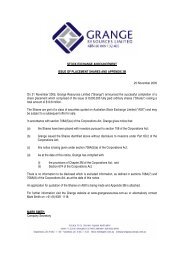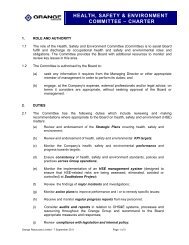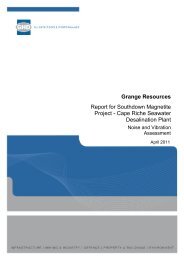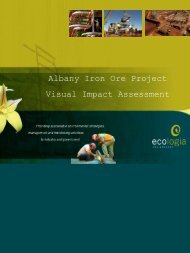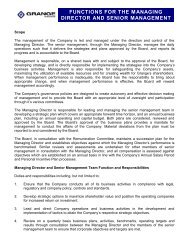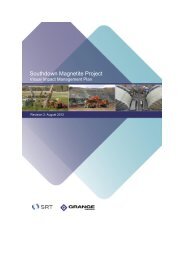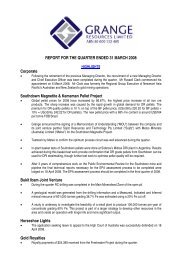Appendix A - Flora and Fauna Survey - Grange Resources
Appendix A - Flora and Fauna Survey - Grange Resources
Appendix A - Flora and Fauna Survey - Grange Resources
Create successful ePaper yourself
Turn your PDF publications into a flip-book with our unique Google optimized e-Paper software.
utilise more open areas such as woodl<strong>and</strong>s, burnt vegetation <strong>and</strong> pasture if connected to more a suitable<br />
habitat or if there are predator control programs in place.<br />
This species was observed during the survey.<br />
Calyptorhynchus latirostris (Carnaby's Cockatoo) – Endangered EPBC Act <strong>and</strong> WC Act<br />
Carnabys cockatoo feed on Proteaceous species of plants from coastal heath <strong>and</strong> shrubl<strong>and</strong>s including:<br />
Banksia, Hakea, Grevillea, Allocasuarina, Eucalypts <strong>and</strong> Pinus plantations.<br />
Strategen (2009) completed a Carnaby’s Black Cockatoo assessment for the mine site. The assessment<br />
sought to evaluate the relative extent <strong>and</strong> significance of impacts to Carnaby’s Black Cockatoo. The<br />
cockatoo was observed in low numbers <strong>and</strong> frequency at the mine site location.<br />
Although no individuals or signs of cockatoo feeding were observed along the pipeline alignment there is<br />
suitable feeding habitat present. However, trees within the alignment are too small to support breeding<br />
hollows. Given the linear <strong>and</strong> fragmented nature of much of the alignment it is anticipated that the<br />
cockatoos may utilise the site as an additional foraging resource.<br />
Falco peregrinus (Peregrine Falcon) – Schedule 4 – WC Act<br />
The Peregrine Falcon prefers areas with rocky ledges, cliffs, watercourses, open woodl<strong>and</strong> or margins<br />
with cleared l<strong>and</strong>. This species requires abundant prey, secure nest sites <strong>and</strong> lack of human interference<br />
(Johnstone <strong>and</strong> Storr, 1998). This species occurs along the southern coast <strong>and</strong> is expected to be a<br />
vagrant visitor to the Study Area. The pipeline alignment <strong>and</strong> outfall contain rocky coastal areas,<br />
however, no nests were observed.<br />
4.3.4 Introduced <strong>Fauna</strong> Species<br />
Two introduced species, Vulpes vulpes, Red Fox <strong>and</strong> Oryctolagus cuniculus, Rabbit, were noted in the<br />
Study Area. These two species are commonly observed <strong>and</strong> are well documented in the south west of<br />
Western Australia.<br />
4.4 Short Range Endemics (SREs)<br />
Short range endemic (SRE) invertebrates are species with naturally restricted distributions. The isolation<br />
of invertebrates in specific habitats or bioregions leads to endemism at various spatial scales. The vast<br />
majority of invertebrates are capable of dispersing substantial distances at some phase of their life cycle.<br />
Some groups, however, are susceptible to short-range endemism, which describes endemic species with<br />
restricted ranges, which has been arbitrarily defined as less than 10,000 km 2 (100 km x 100 km) (Harvey,<br />
2002). Taxa that have been more commonly found to contain short range endemic representatives<br />
include Onychophorans (velvet worms), Arachnids (mygalomorph spiders, pseudoscorpions, opiliones,<br />
scorpions, schizomids), Myriapods (millipedes <strong>and</strong> centipedes), Molluscs (l<strong>and</strong> snails), <strong>and</strong> Insects<br />
(hemipterans, grasshoppers, butterflies).<br />
Many processes contribute to taxa being susceptible to short-range endemism. Generally these factors<br />
are related to isolation of a species which can include the ability <strong>and</strong> opportunity to disperse, life history,<br />
physiology, habitat requirements, habitat availability. Taxa that exhibit short range endemism generally<br />
exhibit poor dispersal, low growth rates, low fecundity <strong>and</strong> reliance on habitat types that are<br />
discontinuous (Harvey, 2002). Taxa that reside within easily isolated habitats surrounded by physical<br />
barriers such as isl<strong>and</strong>s, mountains, aquifers, lakes <strong>and</strong> caves are also more susceptible to becoming<br />
short range endemic species often including additional taxa not otherwise generally forming SRE’s.<br />
20



